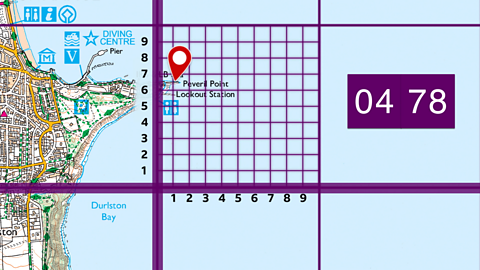What do you know?
What are the three ways of showing averages?
The three main ways of showing averages are by using mean, mode and median.
Key points
- Averages can be shown in three different ways: using mean, mode and median.
- Ratios and proportions are helpful when comparing data sets where there is a relationship.
- When we look at how data has changed over time, we can calculate percentage increase and decrease.
Numeracy in geography
Geographers use numbers - or data - all the time in every area of the subject. Some examples include using climate data when studying ecosystemThe living organisms in a particular area (such as plants and animals), together with the non-living components of the environment (such as rocks and soil)., examining life expectancy when considering developmentThe progress of a country in terms of wealth and human well-being. or measuring river velocityThe speed at which something flows eg water in a river. during a geographical investigation. By studying this data, geographers are able to reach conclusions and interpret patterns and trends.
Video: Numeracy in geography
Numeracy in geography
Numeracy in geography
Geography is about looking for patterns. Take the weather, for example. It changes every day. So, how can we see the bigger picture?
Calculating mean, median and mode averages can help to reveal trends.
Let's look at the midday temperatures for Birmingham in May 2020. To find the average midday temperature for the month, calculate the mean. Add up all the temperatures, which comes to 599, and divide by the total number of days. For May, it's 31. So, the mean midday temperature is 19.32°C.
To find the median, group the data in ascending order and find the middle number. Here, the median midday temperature is 19°C.
The mode provides the most frequent data within a set of information. Here, the most commonly occurring midday temperature in Birmingham was 15°C.
Using averages, we can track what's happening to temperatures over a month, a year or even longer.
Averages
In geography, we collect and look at large amounts of raw data, so it's sometimes useful to use averages. During a data collection such as a pedestrian count, for example, a geographer might do three separate counts at the same location to ensure a good data set. An average of these data would then be used.
One way to calculate an average is by measuring central tendencyA description of the average within a data set. - the average of a set of data. There are three ways of doing this.
Let's take, for example, the following dataset:
1, 4, 3, 3, 2, 5
1. Mean
The mean is calculated by adding up all the values in a data set and dividing this total by the number of values. For example, the numbers in the data set above would be added up to make 18 which would then be divided by 6 to give a mean of 3.
\( \frac{1+4+3+3+2+5}{6} = {3}\)
2. Median
The median is the middle figure in a data set. To work this out, the numbers are placed in numerical order and the central number or numbers identified. In the above example the median would be 3 as the numbers in order would be read 1, 2, 3, 3 4, 5.
The middle numbers here are both 3, meaning that the median is 3.
3. Mode
The mode is the most common value in a set of data. In the data set above, 3 appears twice whereas all the other numbers appear only once. Therefore, the mode in this dataset is 3.
Question
What is the mode value in this data set?
16, 16, 16, 22, 22, 29, 30
The value 16 occurs three times. 22 only occurs twice. The remaining numbers occur only once. The mode value, therefore, is 16.
Quiz: Numeracy in geography
Percentage increase and decrease
Another useful statistic technique is calculating percentage increase or decrease, also known as percentage change. This technique helps us to compare sets of data and to look at how the data may have changed over time.
Calculating percentage change

There are three steps involved in calculating percentage change:
Step 1 - calculate the difference between the two numbers
Step 2 - divide the difference by the original number
Step 3 - multiply the answer by 100 to convert to a percentage

Example
The number of tourists to the UK decreased from 32.3 million in 2019 to 9.7 million in 2020. What is the decrease in visitor numbers, as a percentage?
Step 1 - calculate the difference between the two numbers
32.3 million - 9.7 million = 22.6 million
Step 2 - divide the difference by the original number
22.6 million ÷ 32.3 million = 0.70
Step 3 - multiply the answer by 100 to convert to a percentage
0.70 x 100 = 70%
Conclusion: There has been a 70% decrease in tourists between 2019 and 2020.
Question
A geography student counts the number of cars passing him. In the first hour it was 10 and in the second hour it was 25. By what percentage has the number of cars increased?
Step 1 - calculate the difference between the two numbers.
25 -10 = 15
Step 2 - divide the difference by the original number
15 ÷ 10 = 1.5
Step 3 - multiply the answer by 100 to convert to a percentage
1.5 x 100 = 150%
Conclusion: There was a 150% increase between the first and second hour.
Ratios
ratioA relationship between two quantities eg 1:20000 are used when there is a relationship between two types of data. Ratios are shown as two numbers separated by a colon, like this:
3 : 170
Calculating ratio

To work out the number of doctors per thousand people in a country, for example, the following steps should be taken:
Step 1 - divide the number of doctors by the number of people.
Step 2 - multiply this answer by 1000 as the ratio is not per person but per thousand.

Examples
1. Calculate the number of doctors per thousand people in Cuba.
Step 1- divide the number of doctors by the number of people
97, 000 ÷ 11, 300 000 = 0.00856
Step 2 - multiply this answer by 1000 as the ratio is not per person but per thousand
0.00856 x 1000 = 8.56 doctors per thousand people in Cuba or 8.56 : 1000
2. Calculate the number of doctors per thousand people in the UK.
Step 1- divide the number of doctors by the number of people
187, 419 ÷ 66, 650 000 = 0.002812
Step 2 - multiply this answer by 1000 as the ratio is not per person but per thousand
0.00856 x 1000 = 2.81 doctors per thousand people in the UK or 2.81 : 1000
A ratio is useful as we can compare these two countries even though they have different population sizes. Cuba has 8.56:1000 whereas the UK only has 2.81:1000.
Proportion
proportionA part, share, or number considered in comparison to the whole, eg 1 in 10. is similar to ratio but show differently. For example:
6.6 million people in the UK, in 2020, were reported to have some form of dyslexia. The population of the UK in 2020 was 66 million. This could be expressed as:
\( \frac{6.6m}{66m}\) or \(\frac{1}{10}\)
When the fraction is simplified this is shown as 1 in 10 people in the UK has dyslexia. This means that out of every ten people in the UK, one will have dyslexia. As the two quantities are in proportion to each other, when one quantity is increased or decreased, the other quantity will increase or decrease in the same ratio. For example, if we double the first number, we find that 2 in 20 people have a form of dyslexia.
Quiz: Percentage change, ratio and proportion
GCSE exam dates 2025
Find out everything you need to know about the 2025 GCSE exams including dates, timetables and changes to exams to get your revision in shape.

More on Geographical skills
Find out more by working through a topic
- count1 of 10

- count2 of 10

- count3 of 10
